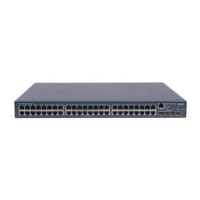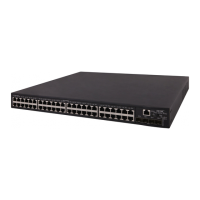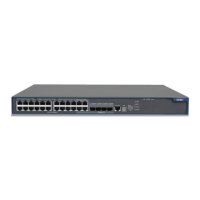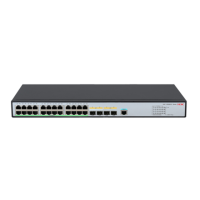1-18
z There is one and only one root bridge in effect in a spanning tree instance. If two or more devices
have been designated to be root bridges of the same spanning tree instance, MSTP will select the
device with the lowest MAC address as the root bridge.
z You can specify multiple secondary root bridges for the same instance. Namely, you can specify
secondary root bridges for the same instance on two or more than two devices.
z When the root bridge of an instance fails or is shut down, the secondary root bridge (if you have
specified one) can take over the role of the primary root bridge. However, if you specify a new
primary root bridge for the instance at this time, the secondary root bridge will not become the root
bridge. If you have specified multiple secondary root bridges for an instance, when the root bridge
fails, MSTP will select the secondary root bridge with the lowest MAC address as the new root
bridge.
z Alternatively, you can also specify the current device as the root bridge by setting the priority of the
device to 0. For the device priority configuration, refer to
Configuring the Priority of the Current
Device
.
Configuration example
# Specify the current device as the root bridge of MSTI 1 and a secondary root bridge of MSTI 2.
<Sysname> system-view
[Sysname] stp instance 1 root primary
[Sysname] stp instance 2 root secondary
Configuring the Work Mode of an MSTP Device
MSTP and RSTP can recognize each other’s protocol packets, so they are mutually compatible.
However, STP is unable to recognize MSTP packets. For hybrid networking with legacy STP devices
and for full interoperability with RSTP-enabled devices, MSTP supports three work modes:
STP-compatible mode, RSTP mode, and MSTP mode.
z In STP-compatible mode, all ports of the device send out STP BPDUs,
z In RSTP mode, all ports of the device send out RSTP BPDUs. If the device detects that it is
connected with a legacy STP device, the port connecting with the legacy STP device will
automatically migrate to STP-compatible mode.
z In MSTP mode, all ports of the device send out MSTP BPDUs. If the device detects that it is
connected with a legacy STP device, the port connecting with the legacy STP device will
automatically migrate to STP-compatible mode.
Configuration procedure
Follow these steps to configure the MSTP work mode:
To do... Use the command... Remarks
Enter system view
system-view
—
Configure the work mode of
MSTP
stp mode { stp | rstp | mstp }
Optional
MSTP mode by default
Configuration example
# Configure MSTP to work in STP-compatible mode.
<Sysname> system-view

